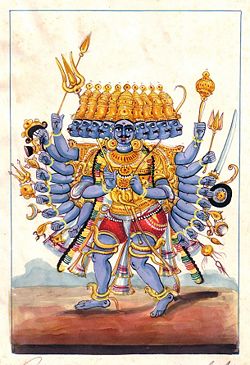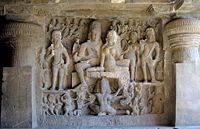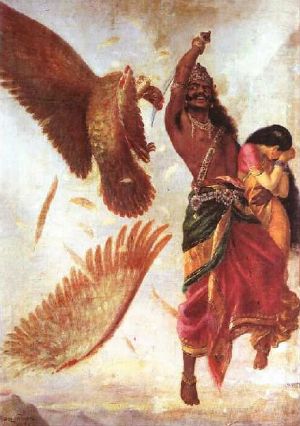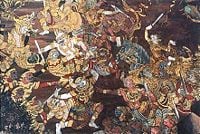Ravana

Ravana (Sanskrit: meaning "of terrifying roar") is one of the principal demons in Hindu mythology who battled against the popular avatar, Rama. Ravana plays a prominent role in the famous Hindu epic, the Ramayana, where, as the king of Lanka, he is both the overlord of the army of Rakshasas (demons) and the abductor of Sita, the wife of Rama. Ravana's arrogance towards the gods, and improper behavior towards Sita, sets in motion a chain of events that culminates in an epic battle between Ravana and Rama, which is chronicled in the Ramayana. Today, Hindus still commemorate the events of the Ramayana in drama and lore, reviving the villainous activities of Ravana, and his seminal role in the popular Hindu myth.
However, Ravana was a tragic figure who engendered his own demise with his unfettered sexual desire and his imperious militarism. As could be expected, he continues to endure as the archetypal villain in the Hindu tradition, and is still identified as such by Hindus today.
Mythology
Early Life
Ravana was born to the Brahmin sage known as Vishrava, and his wife Kaikesi, the Daitya princess. Kaikesi's father, Sumali, king of the Daityas, wished her to marry the most powerful being in the mortal world, so as to produce an exceptional heir. Sumali rejected the other kings of the world, since they were less powerful than him. Kaikesi searched among the sages, and finally chose Vishrava. Vishrava warned her that because she had approached him at an inappropriate time, their children would tend towards evil, but accepted her request for marriage nevertheless. As such, Ravana was partly Daitya, and partly Brahmin. The name that he was given at birth was Dashanana/Dasagriva, referring to the fact that he was born with ten heads.
While Ravana proved to be aggressive and arrogant in nature during his youth, he was also an exemplary scholar. Under Vishrava's tutelage, Ravana mastered the Vedas and the holy books and also the arts. Sumali, his grandfather, worked hard in secret to ensure that he retained the ethics of the Daityas. Ravana was also devoted to the Hindu god Brahma. Following his initial training, he performed an intense penance lasting several thousand years to Lord Brahma. Pleased with his austere penance, Brahma offered Ravana a boon. Ravana asked for immortality, a request which Brahma refused. Ravana then asked for absolute invulnerability and supremacy before the gods and heavenly spirits, as well as the demons, serpents, and wild beasts. Contemptuous of mortal beings, Ravana did not ask for protection from humans. Brahma granted him these boons, and also provided him with great strength by way of sorcery and knowledge of divine weapons.
Conquests
After winning these boons, Ravana sought out his grandfather Sumali and assumed leadership over his army. He then set his sights upon Lanka, an idyllic island society created by the celestial architect Vishwakarma for Kubera, the treasurer of the Gods. Kubera was also the son of Vishrava, and had generously shared all that he owned with Kaikesi's children. Ravana, however, demanded Lanka in it's entirety from him, threatening to take it by force. Vishrava advised Kubera to give up the island to Ravana, who was now virtually invincible. Although Ravana initially took Lanka by force, he was nevertheless regarded as a benevolent and effective ruler since life on the island flourished under his rule.

Following his conquest of Lanka, Ravana encountered Lord Shiva at his abode upon Mount Kailash. Unknowingly, Ravana attempted to uproot and move the mountain on a whim. Shiva, annoyed by Ravana's arrogance, pressed his smallest toe on Kailash, pinning Ravana firmly underneath. Once Ravana was informed of whom he had crossed, he became penitent. For several years he sang songs praising Shiva, until the destroyer god released him from his bondage. Pleased with his bravery and devotion, Shiva granted Ravana further strength, awarding him the Chandrahas (or "Moon-blade"), an immensely powerful sword. Ravana in turn became a lifelong devotee of Lord Shiva. It is also during this incident that Ravana officially acquired his name, which was given to him by Shiva and means "(He) Of the terrifying roar," referring to the fact that the earth is said to have quaked with Ravana's cry of pain when the mountain was pinned upon him.
Ravana's abilities were by now truly awe-inspiring, and so he set out confidently on a series of campaigns to conquer human and celestial beings alike. After vanquishing several kingdoms of the human world, he performed the suitable sacrifices and was crowned emperor. Kubera at one point chastised Ravana for his cruelty and greed, to which Ravana responded by invading the heavens and defeating the devas, singling out his half-brother Kubera for particular humiliation. By the time of the Ramayana, several hundred years later, Ravana is shown as dominating all human and divine races, to the extent that he can dictate when the sun rises and sets.
Wives and Womanizing
Ravana was also known for his aggressive "conquests" of women. He had several wives, foremost of whom was Mandodari, a woman often compared to Sita for her wisdom, grace, beauty, and chastity. Ravana's wives bore him seven sons: Indrajit, Prahasta, Atikaya, Akshayakumara, Devantaka, Narantaka, and Trishira. In addition to his wives, Ravana maintained a harem of incredible size, populated with women whom he captured over the course of his many conquests, many of whom allegedly lived happily under Ravana's captivity on account of his virility and wisdom. Nonetheless, Ravana often forced himself upon any woman who rejected his advances.
It was just this type of rambunctious sexuality that led Ravana into a number of compromising situations. The first was the molestation of the sage-woman Vedavati. Vedavati had been performing penance with the intention of winning Lord Vishnu for a husband. Ravana first eyed her while she sat in her hermitage, her beauty enhanced by the austerities she had performed. Vedavati rejected his advances, so Ravana proceeded to forcibly take her, during which time she prophesied that she would return to the mortal world as the cause of his death. She then created a pyre and threw herself upon it. She was re-born as Sita, thus becoming Vishnu's wife in his incarnation as Rama, the cause of Ravana's defeat.
Another example of Ravana's unmitigated lust was his encounter with the apsara Rambha, another female upon whom he forced himself. Rambha was betrothed to Kubera's son, and so she pleaded to Ravana that she was essentially kin to him, but this did not deter him. Angered at this, Kubera's son cursed Ravana, stating that his ten heads would fall off if he forced himself upon any woman from that point on.
These acts of sexual impropriety culminated in Ravana's decision to kidnap Sita, an act to which all his previous transgressions pale in comparison. This fateful chain of events begin earlier on in the lives of both Rama and Ravana, each of whom was in attendance for the ceremony in which Sita was to choose her husband. In order to determine the suitor, Sita's father King Janaka challenged that any worthy young men should complete the task of wielding the immense bow of Shiva in order to win his daughter's hand. While Rama completed the task handily, Ravana was almost crushed when the bow teetered atop him. Ravana came back into contact with Sita years later after she and Rama, along with his brother Lakshmana, had been banished to the forest. Ravana's sister Surpanakha attempted to seduce Rama and Lakshmana while they were stationed here. The two brothers resisted her temptations, and mutilated her as punishment for her actions. When Surpanakha reported this to Ravana, a plan for revenge hatched in his mind. He sent to the forest a rakshasa disguised as a golden deer. Upon seeing the deer, both Rama and Lakshmana were lead off in its pursuit, while Sita stayed behind at the ashram unprotected. At this point, Ravana crept up on a vulnerable Sita and kidnapped her. The discovery of Sita's absence prompted Rama and Lakshmana to partake on a hazardous search to find her. Sita remained under the captivity of Ravana for one year, all the while protecting her chastity at all costs, completely unwavering in her resolve despite Ravana's courting, cajoling, and assorted threats.
Defeat at the Hands of Rama
After overcoming numerous arduous challenges, Rama entered into Lanka in order to confront Ravana and rescue his wife. Rama offered Ravana a final chance to make peace, suggesting that he immediately return Sita and apologize to both him and his wife. As a minister and brother of Ravana, Vibhishana also advised Ravana to return the kidnapped Sita. However, Ravana rejected these attempts to avoid battle, going so far as to banish his brother from his kingdom. Vibhishana immediately sought protection from Sri Rama, which was granted without hesitation, allowing him to become a great devotee of Rama; in turn, Rama was assisted by Vibhishana, whose knowledge of Ravana's proficiency with black magic and mystical weapons allowed Rama to gain a strategic advantage in the ensuing battle. On the battlefield, Rama slew the most powerful rakshasa commanders, along with hundreds of thousands of rakshasa soldiers, aided by the Vanaras, a race of monkey-men who fought alongside him. In an attempt to create divisions in Rama's ranks, Ravana convinced the Vanaras that Rama considered them to be no more than lowly, expendable animals. However, the faithful monkeys dismissed Ravana's claims and continued to fight.
With his rakshasas neutralized, Ravana was forced to square off against Rama. In their initial battle, Ravana was severely injured, and his chariot and weapons were destroyed. Due to this injury, Rama allowed Ravana to live and return to fight another day. In their next meeting, Ravana unleashed the full extent of his magical abilities while making full use of the boons given to him by Shiva and Brahma. After a drawn-out battle, Rama successfully decapitated Ravana's central head, but another promptly arose in its place. Rama went on to decapitate this head, only to find yet another growing in its place. This re-growth occurred because of a vessel of amrit, the nectar of immortality, which Ravana had stored in his stomach. This cycle of decapitation and regeneration continued on until twilight, when Ravana's magical powers became even more pronounced. At this point, Vibhishana informed Rama of why Ravana's heads were regenerating. Rama then invoked the brahmastra, a weapon of mass destruction, and fired the great arrow into Ravana's midsection, destroying the cache of amrit. With the amrit no longer in effect, Ravana met his demise and Sita was freed.
Depiction
In congruence with his mythological descriptions, Ravana is depicted in art with up to ten heads. His ten heads earned him the names Dashamukha ("The ten-faced"), Dashagriva ("The ten-necked") and Dashakantha ("Ten Throats"). Ravana is also pictured with up to 20 hands, signifying his greed and never-ending want. To illustrate his military might, each and every one of his hands contains a weapon, including the trident, the conch, and the chakra (discus), among others. His skin is typically blue. As the personification of all evil, Ravana has been a popular subject of folk art and sculpture throughout India and Sri Lanka, as well as many other regions to which the Ramayana has spread. One of the most famous depictions is a 45-foot idol of Ravana located in Khonpura in Madhya Pradesh.[1]
Legacy
Ravana's malevolent spirit was not exhausted with his death at the climax of Ramayana; rather, his legacy of evil was reiterated and revisited mythologically and theologically in many later Hindu texts. In the Bhagavata Purana, for instance, Ravana and his brother, Kumbakarna were said to be reincarnations of Jaya and Vijaya, gatekeepers at Vaikuntha, the abode of Vishnu and were cursed to be born on Earth by the Sanatah Kumara monks after refusing these holy men entry. The all-merciful Vishnu agreed that they should be punished but agreed to mitigate their curse. He asked them whether they would want to undergo seven births as devotees of Vishnu or three births as enemies of the Lord. Since they wanted to get back to Vaikuntha as soon as possible, they agreed to be born in three births as enemies of God. In their second of these births, it is said that they were born as Ravana and Kumbhakarna.
Despite his villainous behavior, Ravana is still commonly acknowledged as a great character. He is considered to have possessed several important virtues, the foremost being his knowledge of the sacred books, medicines, and sorcery. Ravana was also a great devotee of Shiva, and is supposed to have composed the dance known as the Shiva Tandava Stotra, according to legend. Further, his skillful leadership is often noted; although Ravana initially took Lanka by force, he was nevertheless an effective ruler, bringing times of great prosperity to the island during his rule. With this in mind, citizens of Khonpura worship their Ravana idol during the Dussera festival, an occasion wherein worshipers everywhere else burn his effigy.
His successes notwithstanding, Ravana was a tragic figure who engendered his own demise with his unfettered sexual desire and his imperious militarism. As could be expected, he continues to endure as the archetypal villain in the Hindu tradition, and is still identified as such by Hindus today.
Notes
- â Khaitan, Rajni, Demon King Ravana's Village in Madhya Pradesh Worships Him.
ReferencesISBN links support NWE through referral fees
- Blank, Jonah. Arrow of the Blue-Skinned God: Retracing the Ramayana Through India. New York: Grove Press. 2000. ISBN 0802137334
- Menon, Ramesh. The Ramayana: A Modern Retelling of the Great Indian Epic. North Point Press. 2004. ISBN 0865476608
- Pattanaik, Devadutt. Indian Mythology: Tales, Symbols and Rituals from the Heart of the Subcontinent. Rochester, VT: Inner Traditions International. 2003. ISBN 0892818700
Credits
New World Encyclopedia writers and editors rewrote and completed the Wikipedia article in accordance with New World Encyclopedia standards. This article abides by terms of the Creative Commons CC-by-sa 3.0 License (CC-by-sa), which may be used and disseminated with proper attribution. Credit is due under the terms of this license that can reference both the New World Encyclopedia contributors and the selfless volunteer contributors of the Wikimedia Foundation. To cite this article click here for a list of acceptable citing formats.The history of earlier contributions by wikipedians is accessible to researchers here:
The history of this article since it was imported to New World Encyclopedia:
Note: Some restrictions may apply to use of individual images which are separately licensed.

